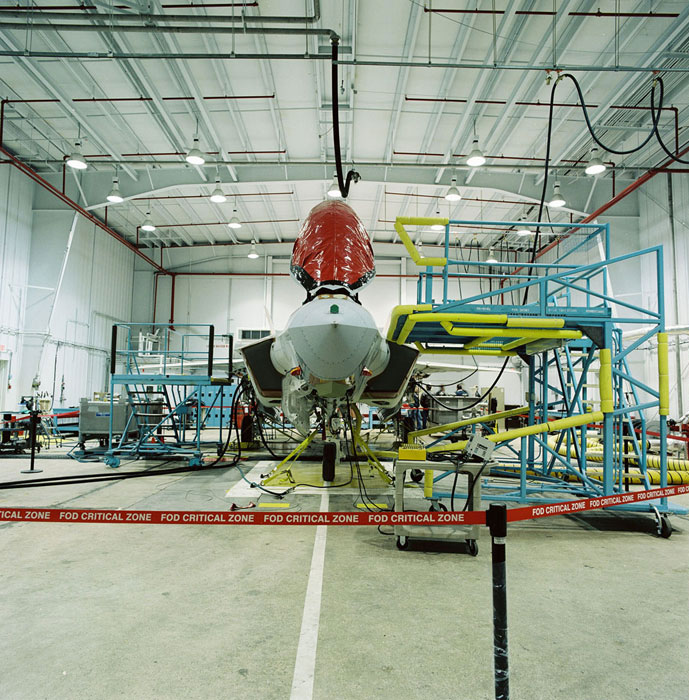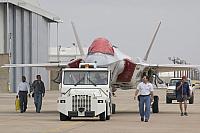Fighter Jet News
F-35 Lightning II News
JSF team finishes F-35 structural testing early
April 17, 2006 (by
Jeff Hollenbeck) -
The F-35 Joint Strike Fighter team successfully completed structural-coupling testing five days ahead of schedule on the first F-35, and moved on to the next scheduled series of ground tests. The F-35's first flight is planned for this fall.
"All of the test results were within the expected range – an excellent indication we thoroughly understand the flight-control system and the aircraft's structural response to flight-control inputs," said Dan Crowley, Lockheed Martin executive vice president and JSF program general manager.
The testing concluded on April 2 and measured the aircraft's structural response to specific flight-control movements. "Flight controls can move very rapidly and generate very large forces that must be passed through the aircraft structure; for every action there is a reaction," said Doug Pearson, Lockheed Martin vice president of the F-35 Integrated Test Force. "Therefore, we need to know exactly how the aircraft structure reacts to a given dynamic flight-control input."
During structural-coupling testing, a wide range of specific flight-control movements are initiated using the on-board aircraft flight-control system. Based on the data collected during the testing, engineers can "tune" the flight-control system to eliminate responses that could potentially damage the aircraft structure. The tuned flight-control system is transparent to the pilot and ensures that the system will be responsive to his or her demands. The test team evaluated eight different F-35 fuel- and weapons-load configurations. The aircraft's two internal weapons bays were fully loaded with inert bombs (Joint Direct Attack Munitions) and air-to-air missiles for the first time, and the weapons-bay doors were opened and closed repeatedly.
F-35 ground vibration testing started on April 11 and involves the use of shaking devices that place loads and movements on flight-control surfaces, and measure the aircraft's response.
The first round of ground tests involved a thorough checkout of the F-35's fuel system during which time no leaks were detected – a first for a modern fighter.
The testing concluded on April 2 and measured the aircraft's structural response to specific flight-control movements. "Flight controls can move very rapidly and generate very large forces that must be passed through the aircraft structure; for every action there is a reaction," said Doug Pearson, Lockheed Martin vice president of the F-35 Integrated Test Force. "Therefore, we need to know exactly how the aircraft structure reacts to a given dynamic flight-control input."
During structural-coupling testing, a wide range of specific flight-control movements are initiated using the on-board aircraft flight-control system. Based on the data collected during the testing, engineers can "tune" the flight-control system to eliminate responses that could potentially damage the aircraft structure. The tuned flight-control system is transparent to the pilot and ensures that the system will be responsive to his or her demands. The test team evaluated eight different F-35 fuel- and weapons-load configurations. The aircraft's two internal weapons bays were fully loaded with inert bombs (Joint Direct Attack Munitions) and air-to-air missiles for the first time, and the weapons-bay doors were opened and closed repeatedly.
F-35 ground vibration testing started on April 11 and involves the use of shaking devices that place loads and movements on flight-control surfaces, and measure the aircraft's response.
The first round of ground tests involved a thorough checkout of the F-35's fuel system during which time no leaks were detected – a first for a modern fighter.
Related articles:
Forum discussion:
Tags
- U.S. Air Force takes first steps toward F-35 production ( 2006-04-11)
- F-35 fuel tests confirm solid, well-built design; structural testing begins ( 2006-03-24)
- First F-35 exits Lockheed Martin factory, prepares for testing ( 2006-02-21)
- F-35 Lightning II news archive
Forum discussion:
- Start a discussion about this article in the F-35 forum.
Tags




